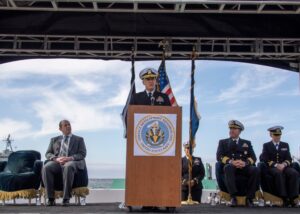The Defense Department’s Strategic Capabilities Office (SCO) fully transferred the Ghost Fleet Overlord unmanned surface vessel (USV) program to the Navy’s Program Executive Office, Unmanned and Small Combatants (PEO USC) on March 3.
SCO began the Ghost Fleet Overlord program in 2018 to help quicken the Navy’s adoption of unmanned and autonomous systems and vessels. The program aimed to convert commercially available vessels to autonomous operations by installing perception and autonomy systems as well as automated and improved ship system reliability for extended missions. The program also developed the command control and communications architecture needed for the system.
The Overlord vessels are based on support craft built for the oil and gas industry but with modifications to operate them remotely from a ground control station.
The Ghost Fleet Overlord program has conducted long endurance transits and participation in fleet exercises, demonstrating the feasibility of using USVs. DoD noted the program especially demonstrated the ability to host and use modular payloads via a realistic concepts of operation.

SCO was able to move quickly and more flexibly by using Other Transaction Authority (OTA) agreements with undisclosed industry development teams.
The office developed two prototype USVs to serve as test beds for the Navy’s Medium and Large Unmanned Surface Vessel Programs of Record, Ranger and Nomad.
The Navy noted that under the SCO’s control the USVs participated in several fleet-level exercises and demonstrations, traveling nearly 29,000 nautical miles in autonomous mode and testing several payloads.
The Nomad completed its long-range autonomous transit from the Gulf Coast to the West Coast last July, spending 98 percent of the time in autonomous mode. The Ranger first underwent that transit in October 2020. Both vessels traveled through the Panama Canal (Defense Daily, July 7, 2021).
“The advances achieved in autonomy, communications and payload integration by Nomad and Ranger are a catalyst for developing the Navy’s future USV programs of record,” the Navy said in a statement.
The Navy is currently in the process of acquiring two more Overlord USV prototypes from the same industry team for additional Navy experimentation. Last year service officials confirmed they are on the way with incremental improvements over the first pair of vessels (Defense Daily, July 14, 2021).
While the Navy has not disclosed the specific industry teams working on the Overlord USVs, last July it told reporters that in fiscal year 2020 the Navy funded Overlord USV prototypes three and four at about $40 million each (Defense Daily, July 15, 2021).
The Navy said the SCO-directed phase of development for the vessels is now over, and the service will continue development and fleet experimentation with the Ranger and Nomad USVs. The service said that in the next phase experimentation will inform the Navy’s unmanned concept development and “directly support the Department’s autonomy modernization priorities and Unmanned Campaign Framework.”
The leader of SCO noted the office and Navy have been working together throughout the program, which will allow for an easy transition.
“The Strategic Capabilities Office partnered with the Navy, Unmanned Maritime Systems (PMS 406) specifically, from the beginning of the Ghost Fleet Overlord Program,” Jay Dryer, director of the Strategic Capabilities Office, said.
“At transition, this enables PMS 406 and the larger team of operators, warfare centers and industry to not miss a beat, continue advancing this technology, and provide a real capability sooner. This is what SCO does best: integrate mature technologies to accelerate service priorities and create new capabilities for the warfighter,” he added.
The initial two Overlord vessels are currently based in California, with Surface Development Squadron One (SURFDEVRON) in San Diego.